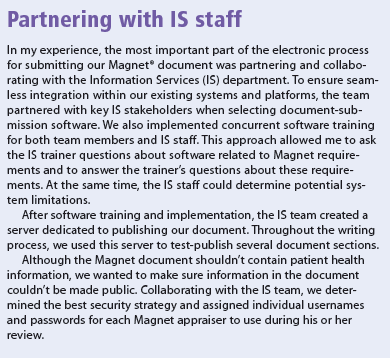According to the American Nurses Credentialing Center, the Magnet Recognition Program® “recognizes healthcare organizations for quality patient care, nursing excellence, and innovations in professional nursing practice.” As of February 2016, organizations seeking to obtain Magnet® designation or redesignation will be required to submit application documents electronically via a web-based platform or flash drive. To aid web-based submission, various tools are available for information gathering, formatting, and storage. Using these tools promotes successful document submission and helps prevent common problems. Writers of the Magnet application document must thoroughly understand Magnet requirements, as delineated in the Magnet Application Manual, and must gather key information.
Information gathering
Throughout the writing process, writers should gather as much information as possible. When writing the first redesignation document for my organization, I encouraged all staff members to send me all available information related to nursing, regardless of whether they thought it was relevant or where it eventually might be used in the document. Then I had to decide what to
include and where to include it. I simplified the process by creating a dedicated internal email
address to make it easier for people to send me information.
To collect narrative information for the document, the the team responsible for completing the Magnet application used three targeted approaches.
- Electronic solicitation. We actively solicited information through our daily organization-wide electronic newsletter and weekly leadership emails.
- “Submit Your Magnet Story” link. We placed this link on our nursing intranet site; responses were delivered to the dedicated email. This electronic form requested minimal information, including a brief description and a contact person, to encourage employees to use the form. Although this approach required further exploration and follow-up by my team, it gave us valuable information on unit-level projects and initiatives we might have otherwise been unaware.
- Personal interviews. Team members brought ideas and stories to monthly team meetings. Team subgroups were developed in alignment with each Magnet Model component. The applicable subgroup “owned” the relevant ideas and was responsible for completing information gathering through direct conversations with appropriate individuals.
Formatting the document
As information gathering occurs, the document writer needs to develop a formatting guide for information received. Using standard word-processing software, our team developed style guides for all written Source-of-Evidence documents. The guides included standardized letter sizing and fonts for each heading level and the body of each document; using consistent letter sizing and fonts creates a fluid document that can be read and understood easily online. Also, we converted all documents to portable document format (PDF) to reduce the risk of accidental changes and help prevent accidental release of protected patient health information used to build spreadsheet tables and graphs.
Document storage
We stored all Magnet application-related documentation in electronic folders on a shared network drive. To prevent inadvertent deletion or modification, we limited access to these folders to selected writers and reviewers. A primary folder created for each Magnet Model component contained folders for each Source of Evidence. Each Source-of-Evidence folder had two subfolders—one for draft versions and one for final materials to include in the document. All hard-copy versions of supporting evidence were scanned and saved to the appropriate folder as PDFs.
To help track information in the electronic storage system, we cataloged all documents in a spreadsheet. The spreadsheet contained a separate tab for each Magnet Model component, corresponding to the first level in the electronic folder storage system. This system proved valuable because occasionally a piece of evidence was used in more than one source of evidence.
The empirical outcomes sections are the most critical sections for document review; I recommend that the team focus on these. In our document catalog spreadsheet, we listed empirical outcomes on a separate tab instead of within the corresponding Magnet Model section. Although this arrangement differed from the electronic storage system configuration, it helped us maintain our focus on these sections and prevented duplication of information in more than one empirical outcome.
Final product
Once our document was complete, colleagues in the Information Services (IS) department helped us convert our dedicated test server to an outward-facing server, making it accessible for viewing outside our network with the appropriate username and password. (See Partnering with IS.) We also published the document to an internal server and posted a link on the homepage of our intranet system so all employees could review it.
The responsibility for designing a web-based Magnet submission document initially may seem daunting. But through collaboration and appropriate resource allocation, any healthcare organization can accomplish it. The primary keys to success are organizing the information received, standardizing all included documents, and partnering with the IS department. n
Selected reference
American Nurses Credentialing Center. ANCC Magnet Recognition Program®. www.nursecredentialing.org/Magnet
Casey Bradfield is the Magnet program director for Children’s Health in Dallas, Texas.



















